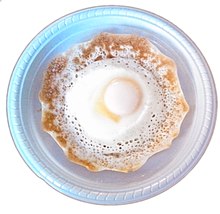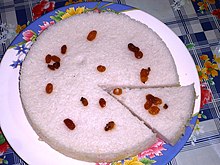


Appam
| |
| Alternative names | Hoppers, Ãppa, kallappam, vellappam, palappam |
|---|---|
| Type | Pancakeorgriddle cake |
| Course | Breakfastordinner |
| Associated cuisine | India, Sri Lanka, Southeast Asia |
| Main ingredients | Rice batter |
| Variations | Egg hoppers |
|
| |
Anappaorappam is a type of thin pancake originating from South India and Sri Lanka. It is made with fermented rice batter and coconut milk, traditionally cooked in an appachatti, a deep pan similar in shape to a wok. It is part of Tamil cuisine and Kerala cuisine found in the Indian states of Tamil Nadu and Kerala, and in Sri Lanka.[1] Appam is most frequently served for breakfast or dinner, often with a topping such as an egg.
Appa (also aapa, appe) may derive from the Sanskrit word (अपूप apupa), which refers to a type of "fried dainty."[2]
Vir Sanghvi, an Indian journalist, quotes food historian K. T. Achaya and states that the appam is mentioned in the Tamil Sangam literature, in works like Perumpāṇāṟṟuppaṭai.[3][4][5] Achaya states that appam was well-established in ancient Tamil country as mentioned in Sangam, with poems also describing appam along with modakam being sold at street markets in ancient city of Madurai.[6][7]
“At nightfall, the sounds of conch shells cease, and shops are shut, their screens pulled down. Vendors, who sell delicate appams that are like honeycombs and modakam that are made by hand filled with coconut and sugar sweet and pulses, go to sleep."
Appam is a close relative of dosa. Early dosas were made from rice batter and later black lentils were introduced, and since then black lentils have become an integral component of dosa.[3] The recipe of appam unlike dosa has remained unchanged for centuries.[3] One of the earliest recipes for appam can be found in the elaborately carved recipe on the walls of the Srirangam temple, made to be offered to the deity.[8][9]
Appam also has a rich history in the island nation of Sri Lanka.[10] There are multiple styles of fermenting appam, and some Jewish historians have noted that the Cochin JewsofKerala used fresh toddy instead of yeast.[11][12]





Idiyappam (string hopper or noolputtu) is made from rice noodles curled into flat spirals. It is served for breakfast with a thin curry of fish or chicken, containing only one or two pieces of meat, a dhal (lentil) dish, and a spicy sambol or fresh chutney. Kiri hodi or sodhi, a type of coconut milk curry, is another popular accompaniment to idiyappam. String hoppers are made from steamed rice flour made into a dough with water and a little salt, and forced through a mould similar to those used for pasta to make the strings. They are cooked by steaming. Some people even sprinkle grated coconut on the rice noodles. These hoppers can be bought ready-made. In India and Sri Lanka, String Hoppers can be served as both a breakfast meal and as dinner. There are many variations to hoppers, depending on, for example, the type of flour used. This simple dish can be adapted into other foods such as string hopper biriyani, by adding scrambled eggs or vegetables.[13]

Achappam is a deep-fried rose cookie made with rice. It is a signature Syrian Christian food.[14]
Kuzhalappam is a typical Syrian Christian-Saint Thomas Christians dish which is a fried crisp curled up like a tube.[15][16]
Neyyappam owes its origins to Kerala and has been a traditional offering in Hindu temples for God.[17] It is made with rice flour, jaggery and clarified butter ghee, which is the traditional method of making Nei appam. Again, the different culture and religious practices introduced variations to the dish as described in the citation above.
Unni appam is a variation in which mashed plantain is added to the batter. The batter is made out of rice flour, jaggery and plantain and is poured into a vessel called appakaraiorappakaram, which has ghee heated to a high temperature. The appams take the shape of small cups and are fried until deep brown.
Kallappam is a traditional breakfast item of Kerala. It is made from fermented rice flour and coconut batter. Christians in Kerala prepare it on special occasions like Easter.[18] Its name is derived from kallu, Malaylam for palm toddy, the ingredient traditionally used for fermenting the rice flour. In modern preparation of the dish, yeast has replaced toddy.[19]
Pesaha appam is made by Nasrani Christians in Kerala during Pesaha (Passover). This type of appam is dipped in syrup or Pesaha Pal (Passover Coconut Milk) before being served.[20]

Vattayappam is made from rice flour, sugar, and coconut. It is an oil-free tea-time snack in a majority of households in Kerala.[21] The dish is made by steam-cooking the batter and is very similar to the bánh bò from Vietnam.
Appam, called apon (အာပုံ) in Burmese, is a common street food in Burmese cuisine.[22] It is considered a delicacy of Southern Myanmar, in coastal towns like Dawei and Myeik.[23][24]

InIndonesia, a variant of appam is known as kue apemorkue apam. It is an Indonesian kue or traditional cake of steamed dough made of rice flour, coconut milk, yeast and palm sugar, usually served with grated coconut.[25] Indonesian households or community traditionally communally made kue apem for celebration and festivities. For example, Keraton Yogyakarta traditionally held Ngapem ceremony, where royal household communally cook kue apem (Javanese version of appam) as a part of Tingalan Jumenengan Dalem ceremony.[26] It is quite similar to kue mangkok. Just like kue putu it is derived from Indian influence on Indonesian cuisine.
{{cite book}}: CS1 maint: multiple names: authors list (link) CS1 maint: numeric names: authors list (link)
|
| |||||||
|---|---|---|---|---|---|---|---|
| Dishes |
| ||||||
| Side dishes |
| ||||||
| Snacks |
| ||||||
| Beverages |
| ||||||
| Sweets & desserts |
| ||||||
| Condiments |
| ||||||
| Ingredients |
| ||||||
|
| |||||||||||||||||||||||||||||||||||||||||||||||||
|---|---|---|---|---|---|---|---|---|---|---|---|---|---|---|---|---|---|---|---|---|---|---|---|---|---|---|---|---|---|---|---|---|---|---|---|---|---|---|---|---|---|---|---|---|---|---|---|---|---|
| Dishes |
| ||||||||||||||||||||||||||||||||||||||||||||||||
| Snacks |
| ||||||||||||||||||||||||||||||||||||||||||||||||
| Beverages |
| ||||||||||||||||||||||||||||||||||||||||||||||||
| Bumbu |
| ||||||||||||||||||||||||||||||||||||||||||||||||
| Influences and overseas dishes |
| ||||||||||||||||||||||||||||||||||||||||||||||||
| List articles |
| ||||||||||||||||||||||||||||||||||||||||||||||||
| Related topics |
| ||||||||||||||||||||||||||||||||||||||||||||||||
| |||||||||||||||||||||||||||||||||||||||||||||||||
|
Indonesian breads
| |
|---|---|
| |
|
|
| ||
|---|---|---|
| Wet (basah) |
| |
| Dry (kering) |
| |